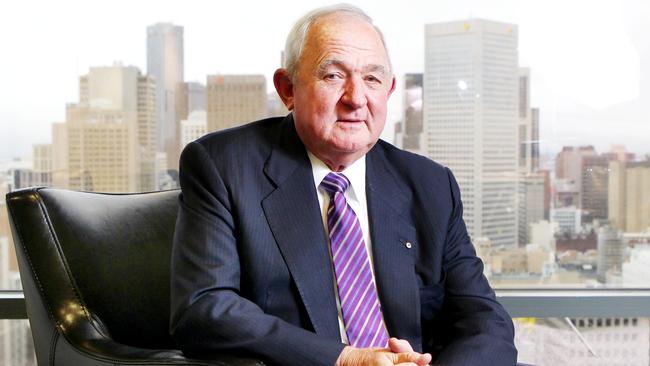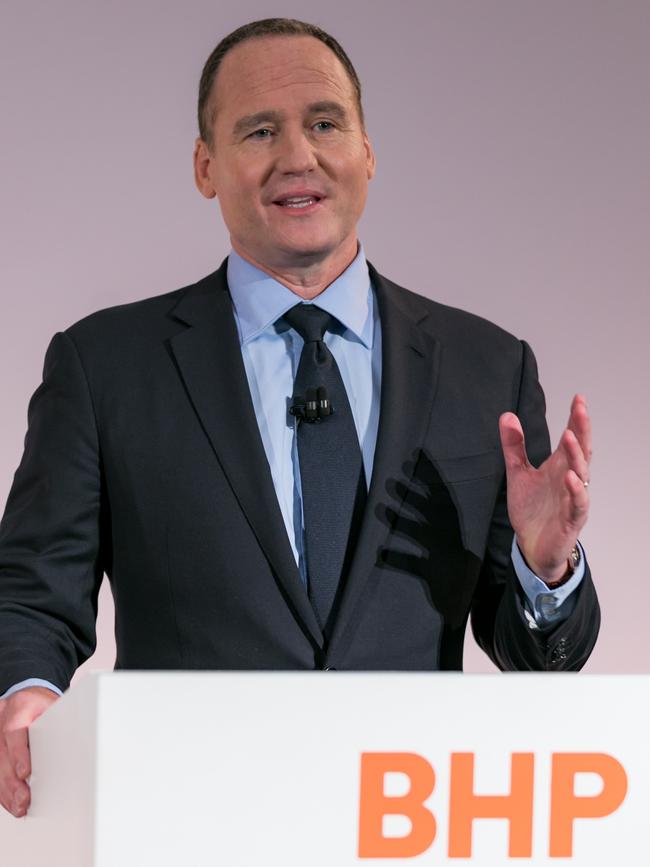Former chairman Don Argus hails BHP’s ‘courageous’ restructure
Former BHP chairman Don Argus has applauded the move by BHP to dissolve the dual-listed company structure he helped create 20 years ago.

Collapsing BHP’s dual listed company structure is no small matter. So it’s little wonder BHP chairman Ken MacKenzie phoned the architect of the original plan, Don Argus, to receive his blessing for the plan on Tuesday.
Mr Argus, chairman of BHP from 1999 to 2010, doesn’t hesitate when asked whether he has any hint of emotion about the dissolution of the corporate structure he put together more than 20 years ago now.
“No, not at all,’’ he tells The Australian with a laugh.
On the contrary, Mr MacKenzie’s move to divest BHP’s petroleum assets in a mega merger with Woodside Petroleum, and in doing so to dissolve the dual-listed company (DLC) structure put together to create BHP Billiton in 2001, is a “courageous” move from a board with the fortitude to do the right thing, Mr Argus says.
Speaking on Tuesday night from Burleigh Heads on the Gold Coast, Mr Argus said he had not even seen the announcements yet, but was impressed by Mr MacKenzie and his board having the grit to go through with the deal and the restructure.
“It’s a great move. You’ve got a management and a board that obviously has the courage to get their balance sheet back to where it should be,’’ Mr Argus said.
“I talk to Ken a fair bit. We have coffee together, and I think I rang him about the speculation about Woodside.
“He wasn’t going to comment on anything … but I’ll give them both a ring tomorrow and congratulate them. I think it’s a great move for the shareholders.
“The DLC was always a short-term thing. They had a few problems there with their flurry into the shale gas in the US … and that probably prevented them getting their balance sheet back to where they wanted to, but it looks like they’re back on track now.
“It’s a courageous thing to make a strategic move like that and I think it’s a great move for the shareholders of BHP.
“All the fund managers, all the five-minute shareholders all want to have a say. But here you’ve got a board that’s got conviction about its future and that’s a good thing.’’
Mr Argus said the DLC structure was probably well past its use-by date.
“The DLC probably could have been collapsed when they did South32, but they had other issues to deal with,” Mr Argus said.
“But there comes a time when you want to get your balance sheet working for you, and when you’ve got a dual-listed company structure you can’t use your paper as effectively as a company that’s got its balance sheet in good shape and can use that paper as currency to do things.
“They’ve got it back on track and it’s great to see.’’
The DLC structure, which involves BHP being split into BHP Group Limited in Australia and BHP Group Plc in the UK, has caused issues for the company at times. It was brought about as a result of the 2001 merger with Billiton Plc, to create BHP Billiton – later rebranded back to simply BHP in 2017.

The tie-up with Billiton, and other corporate manoeuvres including the divestment of the flat steel products division that became the separately listed BlueScope Steel, gave BHP the scale and reach to grow.
The company bought assets such as the huge Olympic Dam polymetallic mine in South Australia, and the value of the company, by the time of Mr Argus’s retirement in 2010, had grown enormously.
But the DLC structure had its critics, with activist hedge fund Elliott Management a thorn in BHP’s side in 2017, agitating for the company to dissolve the dual London and Australian-based company structure, arguing that it could unleash tens of billions of dollars in value.
This would arguably have come from a $US14.1bn increase in BHP’s market value, reflecting strategic, financial, organisational and structural improvements, and $US8.7bn of value unlocked from fully franked dividends and discounted off-market buybacks.
Elliott had built a 5.5 per cent stake in BHP’s London-listed shares – 2.2 per cent of the overall group – and argued for the Big Australian to up sticks and move to London.
Then-treasurer Scott Morrison scuppered any chance of that deal going through, saying he had exercise the government’s right to veto any deal, while pressure from Elliott did motivate the company to exit its significant US shale investments.
While Elliott failed in its bid to untie the DLC knot, BHP said at the time it had already looked at the matter itself, and the $US1.3bn-$US3bn cost of unifying the company had been deemed prohibitive.
In announcing the Woodside deal on Tuesday, BHP said that times had changed, with that cost now dropping steeply to come in at about $US400m- $US500m.
Unpicking the structure will stop the “leaking” of franking credits, and BHP said on Tuesday the Plc side of the business had been underperforming, and had been delivering a “significant reduction in earnings contribution’’.
The rationale for the petroleum deal itself is very much value-driven, according to sources.
It is understood that the thinking was that combining the undervalued Woodside with the undervalued BHP petroleum assets – both coming in at about $US15bn – would create a whole much greater than the sum of its parts.
And while every second conversation in the energy sector currently seems to be about ESG (environmental, social and governance) concerns and how to invest your way through the coming energy transition, the financials, not getting out from under a compliance or PR rock, drove the deal, insiders say, with BHP proper now able to concentrate on its core assets of copper, iron ore and potash.
Mr Argus, for one, is backing the deal to the hilt, and is adamant there is no nostalgia attached to the DLC structure he helped put in place.
“One senior lawyer from the UK said at the time, ‘it’s an elegant way to do a cross-border international transaction’. And we did two of them, Brambles and BHP.
“We collapsed the Brambles one in 2006 or 07. This one has gone on a lot longer than I thought it would have.’’
But now the deal is done – subject to shareholder and regulatory approval – and “it’s great to see a true Australian company. Let’s hope it goes from strength to strength’’.





To join the conversation, please log in. Don't have an account? Register
Join the conversation, you are commenting as Logout